Dentures New Brighton
Reliable, Functional, Beautiful New Teeth

Dentures have been around for centuries. While the materials used to create them have changed, dentists and patients continue to rely on these prosthetics to rebuild smiles and restore oral function. At Crescent Dental, Dr. Helal offers customized dentures in New Brighton to individuals who are missing multiple teeth or entire rows so that they can begin to live life without the worry and embarrassment of an incomplete smile. Call our office to schedule a consultation with our team.
Why Choose Crescent Dental for Dentures?
- Digital Impressions Used to Capture Precise Images
- Natural-Looking Materials for Blended Smiles
- In-House Membership Program for Uninsured Patients
Types of Dentures
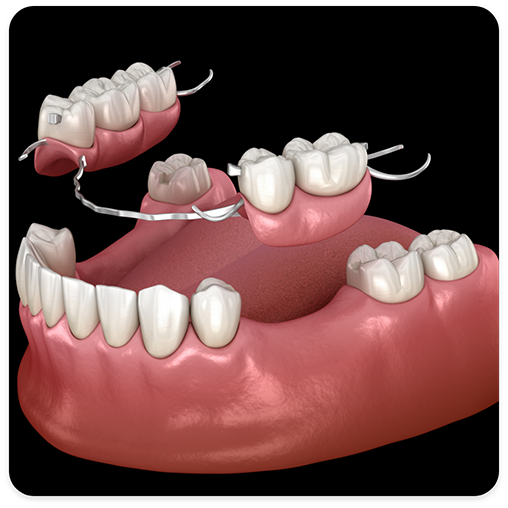
Complete dentures replace all teeth, while a partial denture fills in the spaces along an arch and prevents other teeth from changing position.
Candidates for complete dentures have lost most or all of their teeth, but a partial denture is suitable for those who have some natural teeth remaining. No matter which type of denture is selected, it can help improve a person’s chewing ability and speech as well as provide support for facial muscles. It can greatly enhance a person’s overall appearance and smile.
Complete dentures are made when all of an individual’s natural teeth are missing. It’s possible to have a full denture on the upper or lower jaw or both.
Complete dentures are called “conventional” or “immediate” according to when they are made and when they are inserted into the mouth. Immediate dentures are inserted after the removal of the remaining teeth. To make this possible, the dentist takes measurements and makes models of the patient’s jaws during a preliminary visit.
An advantage of immediate dentures is that the wearer does not have to be without teeth during the healing period. However, bones and gums can shrink over time, especially during the period of healing in the first six months, after the removal of teeth. When gums shrink, immediate dentures may require rebasing or relining to fit properly. A conventional denture can then be made once the tissues have healed, which can take at least 6-8 weeks.
An overdenture is a removable set of teeth that fits over a small number of remaining teeth or implants. Natural teeth must be prepared to provide stability and support for dentures.
Partial dentures are often a solution when several teeth are missing.
Removable partial dentures usually consist of replacement teeth that are attached to pink or gum-colored plastic bases, which are connected by a metal framework. Removable partial dentures attach to your natural teeth with metal clasps or devices called precision attachments. They are generally more esthetic than metal clasps and are nearly invisible. Crowns on your natural teeth may improve the fit of a removable partial denture, and they are usually required with attachments. Partials with precision attachments generally cost more than those with metal clasps.
How are Dentures Made?
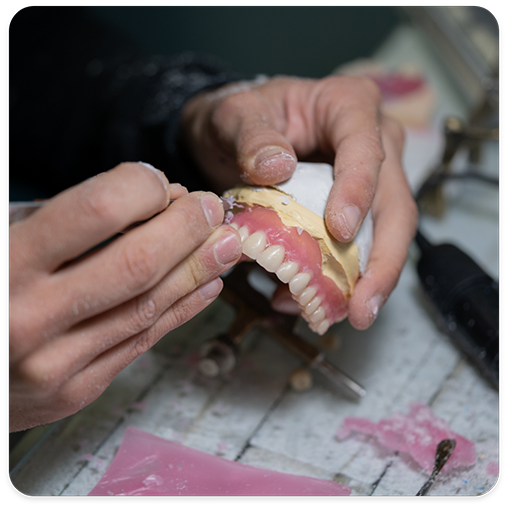
The denture process takes about one month and five appointments: the initial diagnosis is made; an impression and a wax bite are captured to determine vertical dimensions and proper jaw position; a “try-in” is placed to ensure proper color, shape, and fit; and the patient’s final denture is placed, following any minor adjustments.
First, an impression of your jaw is made using special materials. In addition, measurements are made to show how your jaws relate to one another and how much space is between them (bite relationship). The color or shade of your natural teeth will also be determined. The impression, bite, and shade are given to the dental laboratory, so a denture can be custom-made for your mouth.
Traditionally, a dental laboratory makes a mold or model of your jaw, places the teeth in a wax base, and carves the wax to the exact form wanted in the finished denture. With the advanced technology at Crescent Dental and our local lab, we now make “digital dentures.” Instead of a “wax try-in” you will have a 3D printed denture replica to try out; you can even take it home for a few days to test it out! Once you approve, the lab will convert your denture replica into your real denture. With this digital technology, the lab will keep a record of your denture so if it gets lost or broken, they can simply hit “remake” in their computer and you’ll get a new denture without repeating the five appointments again. This is so helpful for patients with dementia who may lose or misplace their dentures.
Getting Used to Your Denture

For the first few weeks, a new denture may feel awkward or bulky. However, your mouth will eventually become accustomed to wearing it. Inserting and removing the denture will require some practice. Your denture should easily fit into place. Never force the partial denture into position by biting down. This could bend or break the clasps or hurt your supporting teeth.
At first, you may be asked to wear your denture all the time. Although this may be temporarily uncomfortable, it is the quickest way to identify those denture parts that may need adjustment. If the denture puts too much pressure on a particular area, that spot will become sore. Your denture can be adjusted to fit more comfortably. After making adjustments, you may need to take the denture out of your mouth before going to bed and replace it in the morning.
Start by eating soft foods that are cut into small pieces. Chew on both sides of the mouth to keep even pressure on the denture. Avoid sticky or hard foods, including gum.
Caring for a Denture
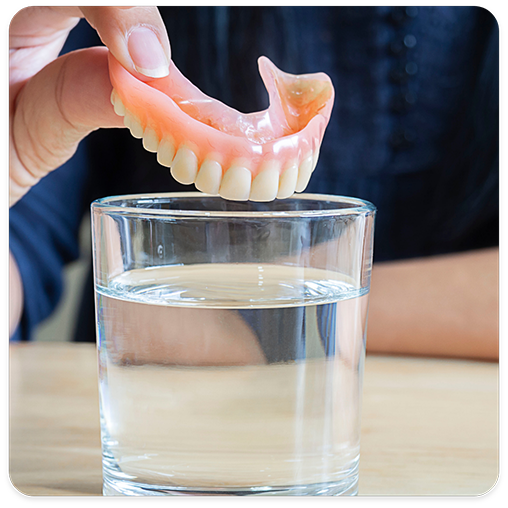
It’s best to stand over a folded towel or a sink of water when handling your prosthetic, just in case you accidentally drop it. Brush the denture (preferably with a denture brush) daily to remove food deposits and plaque and keep it from becoming permanently stained. Avoid using a brush with hard bristles, which can damage the material. Look for denture cleansers with the American Dental Association (ADA) Seal of Acceptance. Pay special attention to cleaning teeth that fit under the denture’s metal clasps. Plaque that becomes trapped under this area will increase the risk of tooth decay.
Hand soap or mild dishwashing liquid to clean dentures is also acceptable. Other types of household cleaners and many kinds of toothpaste are too abrasive and should not be used for cleaning these artificial teeth. A denture can lose its proper shape if it is not kept moist. At night, the denture should be placed in some water. However, if the appliance has metal attachments, they could be tarnished if placed in a soaking solution.
Even with full dentures, you still need to take good care of your mouth. Every morning, brush your gums, tongue, and palate with a soft-bristled brush before reinserting your dentures. This removes plaque and stimulates circulation in the mouth. Selecting a balanced diet for proper nutrition is also important for maintaining a healthier oral environment.
Denture Adjustments
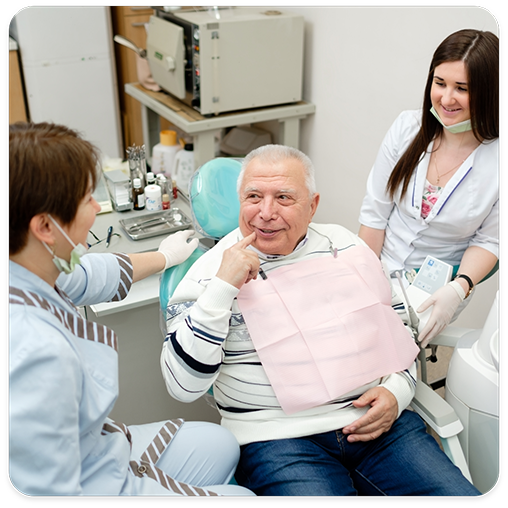
Over time, adjusting the denture may be necessary. As you age, your mouth naturally changes, which can affect the fit of your prosthetic. Your bone and gum ridges can recede or shrink, resulting in a loose-fitting denture. This can cause various problems, including sores or infections. Dentures that do not fit properly can be adjusted. Avoid using a do-it-yourself kit to adjust them, as this can damage the appliance beyond repair. Glues sold over the counter often contain harmful chemicals and should not be used.
If your denture no longer fits properly, if it breaks, cracks, or chips, or if one of your teeth becomes loose, see your dentist immediately. In many cases, dentists can make necessary adjustments or repairs, often on the same day. Complicated repairs may require that the denture be sent to a special dental laboratory.
Over time, dentures will need to be relined, re-based, or re-made due to normal wear. To reline or re-base a denture, the dentist uses the existing artificial teeth and refits the denture base or makes a new one. Dentures may need to be replaced if they become loose and the teeth show signs of significant wear.
Common Concerns with Dentures

Eating will take a little practice. Start with soft foods cut into small pieces. Chew slowly using both sides of your mouth at the same time to prevent the dentures from tipping. As you become accustomed to chewing, add other foods until you return to your normal diet. Be cautious with hot or hard foods and sharp-edged bones or shells.
Some people worry about how dentures will affect their speech. Pronouncing certain words may require practice. Reading out loud and repeating troublesome sounds and syllables will help. If your dentures “click” while talking, speak more slowly. You may find that your dentures occasionally slip when you laugh, cough, or smile. Reposition the dentures by gently biting down and swallowing. If a speaking problem persists, consult your dentist.
What are Denture Adhesives?
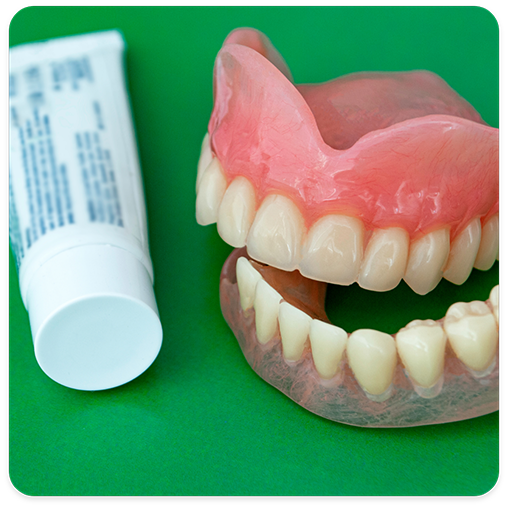
Denture adhesives can provide additional retention for well-fitting dentures. They can also help seal out food so that debris doesn’t collect under your denture as you eat. However, they are not the solution for prosthetics that are old or do not fit correctly. A poorly fitting denture, which causes constant irritation over a long period, may contribute to the development of sores. These dentures may need to be relined or replaced. If your dentures begin to feel loose or cause pronounced discomfort, consult with your dentist immediately.

